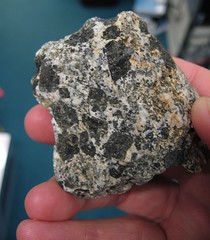
The New York Times has a surprising article today about the radiation risks of granite counters.
Granite is an intrusive rock--slowly cooled from magma several kilometers below the surface, the rock grows large crystals from the hundred-thousand to million year cooling period. It is also chemically more "continental"; that is, more quartz, more "felsic" minerals, as opposed to the "mafic" minerals that contain much olivine and pyroxene, two minerals rich in iron and magnesium. True granite is a chemically specific intrusive, and much of what is called granite isn't, but a cousin of it. Roughly you can say to expect quartz, feldspar (of some type, there are several), and a sheet silicate like mica or biotite.
Despite the popular image of the Earth's crust riding on an ocean of molten magma, there is little liquid under our feet. While it's hot, there is enough pressure to keep things solid. Occasionally something will upset that balance and allow the rock to melt, whether by bringing hot material up to a lower pressure (like at the mid-ocean ridges) or by adding a special ingredient to make it melt (like water released by ocean sediments subducting under a continent). Melting is complicated and rarely complete, and some minerals melt at a lower temperature than others, leaving behind and chemically changing what sort of rock it is. Granite is like this. It melts at a lower temperature than basaltic materials. It often contains more water. And it brings with it certain compatible elements including uranium and thorium. This is why granites are more radioactive than most rocks. They can contain 10-20x more uranium and thorium than the solid left behind. Some of the more exotic "granites" are pegmatites--the extremely large crystal remnants of the last little bits of liquid at the end of solidification--and they contain the highest amounts of these elements.
But is this a hazard? Granites I've encountered have rates ranging from nothing to about 10x background. This isn't that much. Time spent at cruising altitude is about 40x background at 500ft. It certainly wouldn't be worth the fuss of ripping up a kitchen, unless it was proven to be the source of elevated radon levels. After reading the literature about naturally occurring radon sources, I have difficulty assigning the radon to just a small granite piece. Any soil or rock within 4 gas-diffusion-days of the basement or slab can be a source of radon for a home, and the total amount of uranium in that quantity is going to exceed the amount in the countertop (especially the part of the countertop that is within radon's half-life time of the surface). If you covered your walls in granite it might be different.
2 comments:
I want to followup with a comment that the idea in the article that any amount of radiation, no matter how small, is harmful is a matter of great debate. There are two competing ideas, one called the linear no-threshold theory, and the other a threshold theory. Linear no-threshold theory extrapolates from known dose/risk values (from high levels of radiation and increased cancer risks) down to the small levels in everyday life. Threshold theory holds that biological processes can fix radiation damage to some extent under a certain level of damage (a la fixing DNA T-T bindings damaged from UV light). NEI Nuclear Notes brought up the controversy just today.
Mr. Armstrong,
Were 10 times background radiation the upper limit, there would be less concern. Granite slabs with hundreds of times background can be found at the upper end slab yards. Look at our youtube.com site to get an idea of what the higher level slabs emit.
http://www.youtube.com/user/TCSRock78
As to Radon emanation, I also initially scoffed at the idea until I saw it with my own eyes. Dr. Kitto predicted up to 24 pCi/L from some granite types, and he verified the level of the Sugarman home(NY Times story case) from lab testing of portions of the countertop.
We have a full scale Radon test running this month, 18 square feet of Four Seasons granite countertop in a room 8' x 12' x 8' tall. The countertop is 50% smaller than the average amount of countertop per kitchen square footage.
Here is a link to our Radon test
http://forum.solidsurfacealliance.org/viewtopic.php?f=7&t=98
Look around the forum section and you will find pictures of the testing room and more info.
Leakage of the room is keeping the levels a little under 10 pCi/L, equivalent to smoking 1 1/2 packs of cigarettes per day according to the EPA information.
Lastly, were this issue overblown, neither the AARST (Radon scientists) nor the Crcpd (State radiation officials) would have formed committees for setting protocols and maximum level of radiation allowed for residential use. ANSI and ASME are also looking into setting standards for their groups, currently conducting conference calls on the issues.
Most granites are relatively safe, maybe 80% or more. That said, the stone industry needs to be forced to divulge the occurance of radioactive materials prior to sale so the consumers can make an informed decision. Some like myself will not want a material that doubles the background radiation levels in my kitchen, much less 10 times that level.
And I am a granite fabrication shop owner. We pre screen all slabs, every single square foot, and tell the customer what they are purchasing in addition to a countertop. Then they get to make the choice on whether the small risk is warranted by having granite in their home.
Post a Comment